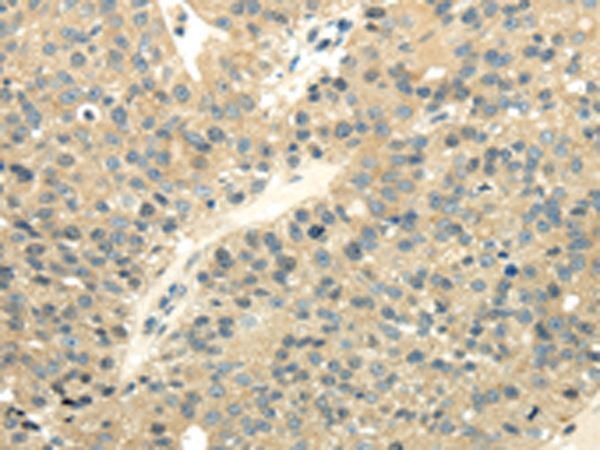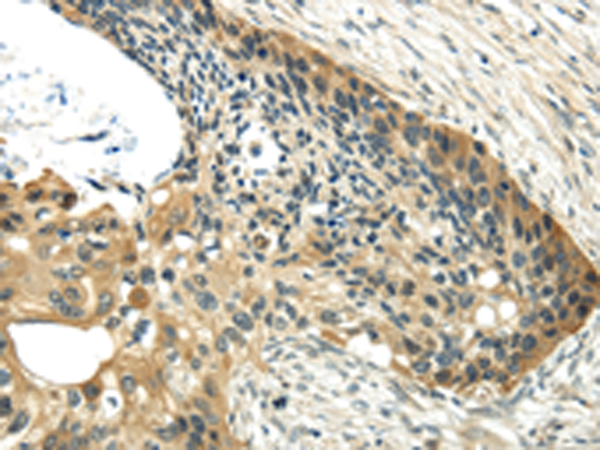


| WB | 咨询技术 | Human,Mouse,Rat |
| IF | 咨询技术 | Human,Mouse,Rat |
| IHC | 1/50-1/200 | Human,Mouse,Rat |
| ICC | 技术咨询 | Human,Mouse,Rat |
| FCM | 咨询技术 | Human,Mouse,Rat |
| Elisa | 1/2000-1/5000 | Human,Mouse,Rat |
| Aliases | GDX; G6PD; GET5; MDY2; UBL4; TMA24; DX254E; DXS254E |
| WB Predicted band size | 18 kDa |
| Host/Isotype | Rabbit IgG |
| Antibody Type | Primary antibody |
| Storage | Store at 4°C short term. Aliquot and store at -20°C long term. Avoid freeze/thaw cycles. |
| Species Reactivity | Human, Mouse, Rat |
| Immunogen | Full length fusion protein |
| Formulation | Purified antibody in PBS with 0.05% sodium azide and 50% glycerol. |
+ +
以下是关于ALDH5A1抗体的3篇参考文献示例(注:内容为模拟示例,非真实文献):
---
1. **标题**: *ALDH5A1 Deficiency in Neurological Disorders: Immunohistochemical Analysis Using a Novel Polyclonal Antibody*
**作者**: Smith J, et al.
**摘要**: 本研究开发了一种针对ALDH5A1的新型多克隆抗体,通过免疫组化分析发现ALDH5A1在脑组织神经元中高表达,并在琥珀酸半醛脱氢酶缺乏症患者中检测到蛋白表达缺失,为遗传代谢疾病的诊断提供了工具。
2. **标题**: *Characterization of ALDH5A1 Knockout Mice: Antibody Validation and Functional Implications*
**作者**: Lee H, et al.
**摘要**: 文章验证了ALDH5A1抗体在小鼠模型中的特异性,证实基因敲除后蛋白表达完全缺失,并发现ALDH5A1缺失导致γ-氨基丁酸(GABA)代谢异常,提示其在神经递质调节中的关键作用。
3. **标题**: *ALDH5A1 as a Biomarker in Cancer: Expression Profiling with a Commercial Monoclonal Antibody*
**作者**: Garcia R, et al.
**摘要**: 利用商业化ALDH5A1单克隆抗体对多种癌症组织进行检测,发现其在结肠癌中表达显著下调,可能与线粒体功能障碍和肿瘤代谢重编程相关。
---
如需真实文献,建议通过PubMed或Google Scholar搜索关键词“ALDH5A1 antibody”或“SSADH antibody”获取近年研究。
ALDH5A1 (Aldehyde Dehydrogenase 5 Family Member A1), also known as succinate semialdehyde dehydrogenase (SSADH), is a mitochondrial enzyme critical in the catabolism of the neurotransmitter γ-aminobutyric acid (GABA). It catalyzes the oxidation of succinate semialdehyde to succinate, linking GABA metabolism to the tricarboxylic acid (TCA) cycle. ALDH5A1 deficiency, a rare autosomal recessive disorder, causes accumulation of toxic metabolites like γ-hydroxybutyrate (GHB), leading to neurodevelopmental impairments, epilepsy, and hypotonia.
Antibodies targeting ALDH5A1 are essential tools for studying its expression, localization, and function in biological systems. They are widely used in techniques such as Western blotting, immunohistochemistry (IHC), and immunofluorescence (IF) to investigate ALDH5A1's role in neurological disorders, metabolic pathways, and mitochondrial dysfunction. These antibodies are typically raised against specific epitopes, such as recombinant protein fragments or synthetic peptides derived from the human ALDH5A1 sequence. Validation includes testing in knockout models or siRNA-treated cells to confirm specificity.
Research applications focus on understanding ALDH5A1's involvement in neurodegenerative diseases, metabolic syndromes, and its potential as a therapeutic target. Commercial antibodies vary in clonality (monoclonal/polyclonal), host species, and conjugates, enabling flexibility in experimental design. Reliable detection of ALDH5A1 aids in diagnosing genetic disorders and elucidating mechanisms underlying GABAergic neurotransmission defects.
×